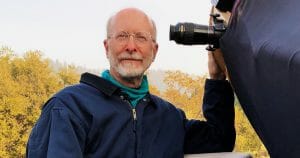Born in Portsmouth, Virginia, by age 8 Machholz [pronounced ma-coles] had a fascination for the night sky, thanks to his older sister telling him about meteors. By 13 he had his own telescope to get a closer look. And by 23 he decided he was going to discover a comet. Where he lived in California, he said, there were only about 185 cloudless and moonless nights to enable comet hunting, which he did by looking for them, a “visual” search. It took about 1,700 hours of observations over more than three years, but he did it on his 691st night of comet hunting: on Sept. 12, 1978 — Comet Machholz (1978l) was named for him. The second one took 1,742 hours over a span of more than seven years. That one, which he found on May 27, 1985, is dubbed Comet Machholz (1985e). He found it with a home-made 10-inch telescope on his 1,385th night of comet hunting.

Well, he couldn’t stop there: in 1986 he found a periodic comet — one with an orbit that will bring it back to the sun at a calculated time. Dubbed 96P/Machholz, it was discovered on June 6, 1986 using binoculars(!), and is a short-period comet: it orbits the sun at a pretty fast clip — every 5.29 years — and has been photographed on return visits. Once he found an object he suspected to be a comet, Machholz had to carefully chart exactly where in the night sky it was, relative to known stars, galaxies, or nebulae. Then comes the check of the New General Catalogue of Nebulae and Clusters of Stars (aka “NGC”), an astronomical catalogue of deep-sky objects compiled by John Louis Emil Dreyer in 1888, which, with its supplements, charts more than 13,000 known astronomical objects — he has to confirm what he “found” isn’t something already known to be in that spot. Next he watches for movement, since a comet will in general move a noticeable amount of distance in about an hour, which goes back to careful charting. Once confirmed to his satisfaction, the next step is to report it to the Smithsonian Astrophysical Observatory in Cambridge, Mass., which is the clearinghouse for comet discoveries, and wait for confirmation by other observers.


Machholz followed that procedure again and again, finding Comet Machholz (1988j) in 1988, and Comets Tanaka-Machholz (1992d) and Comet Machholz (1992k) in 1992. In 1994 he found three: Comet Nakamura-Nishimura-Machholz (1994m), Comet 141P/Machholz 2 (another periodic), and Comet Machholz 1994r, his 7-9th find, which pushed him ahead of David Levy, until then the most prolific visual comet hunter. Since then, Levy has found one more visually, in 2006. Machholz found three more since then: Comet Machholz (C/2004 Q2) in 2004, Comet Machholz C/2010 F4 in 2010, and C/2018 V1 (Machholz-Fujikawa-Iwamoto) in 2018. In his off hours, Machholz served in the U.S. Army as a weather observer, wrote books and for astronomy magazines, hosted a popular podcast, and received numerous awards for his work. In all he discovered 12 previously unknown comets, making him the most prolific visual comet finder in history. He died August 9 at his home in Arizona (from Covid-19, his wife told me in an email), at 69.
Side Note: The Honorary Unsubscribe tells stories of “the people you will wish you had known.” I didn’t know Machholz, but I spent quite a few hours with astronomer David Levy and his wife, Wendy, which included discussions about comets. Levy’s most notable co-discovery was Comet Shoemaker–Levy 9 in 1993, which became very well known because it slammed into Jupiter in 1994. That meeting is in my blog with a photo of us at Let’s Go to Pluto!.
